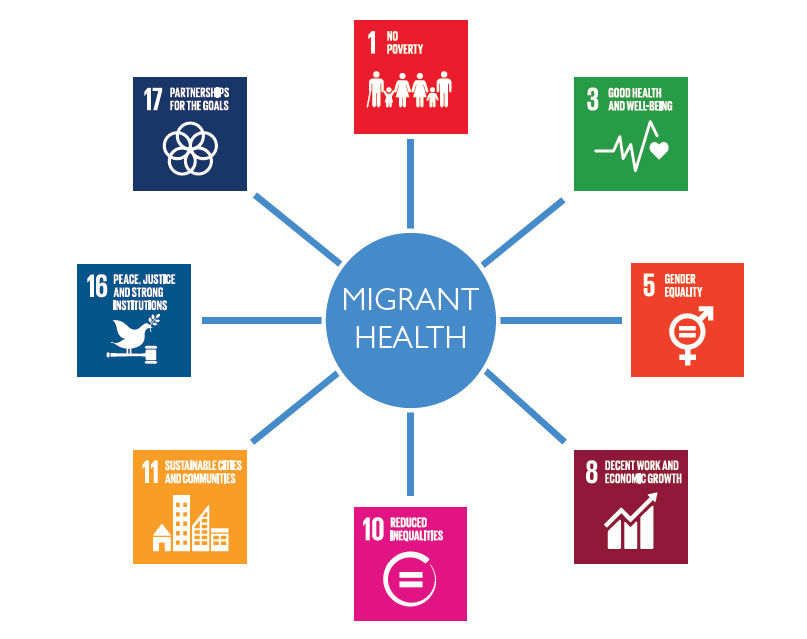-
Who we are
WHO WE AREThe International Organization for Migration (IOM) is part of the United Nations System as the leading inter-governmental organization promoting since 1951 humane and orderly migration for the benefit of all, with 175 member states and a presence in 171 countries.
-
Our Work
Our WorkAs the leading inter-governmental organization promoting since 1951 humane and orderly migration, IOM plays a key role to support the achievement of the 2030 Agenda through different areas of intervention that connect both humanitarian assistance and sustainable development.
What We Do
What We Do
Partnerships
Partnerships
Highlights
Highlights
- Where we work
-
Take Action
Take Action
Work with us
Work with us
Get involved
Get involved
- Data and Research
- 2030 Agenda
With migration being such a prominent factor in daily life today, the international society has progressively grown more aware of how migrants actively contribute to positive development outcomes in both host and origin countries. Yet, they are often marginalized and face considerable barriers in accessing health care services; as a result, their ability to remain healthy and productive can be compromised.
A milestone in this context is the 2030 Agenda for Sustainable Development, officially adopted by the United Nations in September 2015. Setting 17 detailed and comprehensive goals to be achieved for a sustainable development, the 2030 Agenda presents opportunities and challenges with respect to meeting the needs of migrants, which have been of major concern for IOM’s Migration Health Division.
In the wake of the 2030 Agenda call to “Leave No One Behind”, Governments are encouraged to integrate the health needs of migrants into national plans, policies, and strategies across sectors. While many goals, declined in their several targets, can be extensively interpreted and linked to the multi sectoral domain of migration health, there are some whose interpretation is particularly compelling. Entry points into the Sustainable Development Goals for migrant health include for example:
- Goal 1
-
Target 1.3: Implement social protection systems including floors and achieve sustainable coverage of the poor and vulnerable
Target 1.5: Strengthen resilience of the poor and most vulnerable to economic, social and environmental shocks and disasters - Goal 3
-
Target 3.8: Achieve Universal Health Coverage
Target 3.c: Increase health financing and establish a sufficient health workforce in developing countries
Target 3.d: Increase capacity of countries for early warning, risk reduction and management of national and global health risks - Goal 5
-
Target 5.2: Eliminate all violence against women and girls
Target 5.6: Ensure universal access to sexual and reproductive health and reproductive rights - Goal 8
-
Target 8.7: Eradicate forced labour, end modern slavery and human trafficking; eliminate child labour
Target 8.8: Protect labour rights and promote safe and secure working environments for all workers including migrant workers - Goal 10
-
Target 10.7: Orderly and safe migration through well-managed migration policies
- Goal 11
-
Target 11.1: Access to adequate housing and basic services; upgrade slums
Target 11.5: Reduce deaths and number of people affected and decrease the economic losses following disasters - Goal 16
-
Target 16.1: Reduce violence and related death rates
Target 16.2: End abuse, exploitation, trafficking, violence against and torture of children - Goal 17
-
Target 17.16: Utilize global and multistakeholder partnerships to support the achievement of sustainable development goals in all countries
Target 17.18: Assist developing countries in increasing the availability of high-quality data disaggregated by migratory status

It is in fact now widely understood that being and staying healthy is not only part of migrants’ human rights, but also a fundamental precondition for them to work, be productive and contribute to the social and economic development of their communities, both of origin and destination.
Therefore, coordinated efforts are needed to ensure that migrant health is addressed throughout the migration cycle, as are efforts to adapt and strengthen the resilience of local health systems in light of more diverse population health profiles. Addressing the health of migrants and affected local populations reduces long-term health and social costs, is good public health practice, facilitates integration and contributes to social and economic development. The healthier migrants are and remain, the more efficient and balanced the future of our highly mobile and globalized society will be.